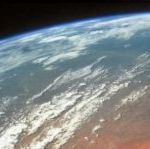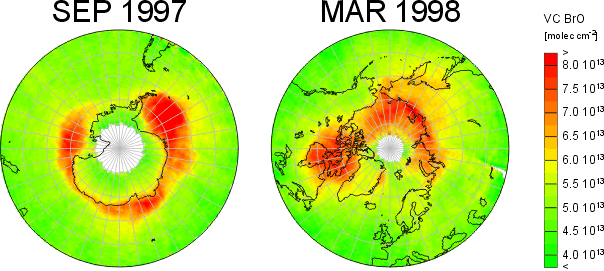
Tropospheric BrO from GOME measurements
Introduction Data Animated Images References Links Contact
 Introduction:
Introduction:
Ground based observations of ozone in the polar boundary layer have shown frequent episodes of extremely low concentrations in polar spring in both hemispheres. These “low ozone events” are accompanied by strong increases in filterable bromine and also in bromine oxide (BrO). It is assumed, that boundary layer ozone is destroyed by halogen catalysed cycles very similar to those operating in the stratosphere, but with a strong emphasis on bromine compounds and recycling on and in aerosols rather than in the gas phase. How the bromine is released in the atmosphere is not fully understood, but frost flowers forming on new sea ice or aerosol created from wind blown frost flowers are the most probable explanation.
More recently, a link has also been established between low ozone events and
the conversion of gaseous to particulate mercury compounds and subsequent deposition on snow/ice. This is an important mechanism
of mercury injection into the polar biosphere, and probably is the reason for the enhanced Hg levels observed in the Arctic and
also people strongly depending on sea food.

With the GOME instrument, it is for the first time possible to map
tropospheric BrO on a global scale, even in remote regions and over the ice caps. The measurements show, that bromine activation
(and therefore low ozone) in the boundary layer is not an episodic event but rather a regular feature of polar spring in both hemispheres and
extends over large areas and several weeks. BrO in the two hemispheres shows systematic differences that are linked to the different sea land distribution.
In the North, most BrO is formed along the coast lines of the Arctic sea, over the polar ice cap and also over the Hudson Bay. In
the South, a ring like structure of BrO forms over the ice sheet around Antarctica, but little BrO is found over the continent
itself. A similar observation can be made in Greenland. This can be understood if sea ice and some open water is necessary in the
BrO formation, a condition found along coast lines and over broken ice but not inlands.
 Data:
Data:
Daily images of total BrO columns based on GOME Near Real Time data can be found on the GOME NRT page.
Daily and monthly averages can be downloaded as ASCII files on our data page.
Monthly averages for the two hemispheres can be viewed from the links below:
|
||||||||||||||||||||||||||||||||||||||||||||||||||||||||||||||||||||||||||||||||||||||||||||||||||
|
If you have specific requests for plots or data, please contact Andreas Richter.
 Animated
Images:
Animated
Images:
Below you can view or download animated GIF-files of Arctic and Antarctic BrO as measured by GOME during the spring periods. The files are about 3 MByte each. Please note, that no cloud correction has been performed and therefore some BrO might be hidden below clouds. The images are three day composites, showing the maximum value observed during this time period.
| NH 1997 | SH 1997 |
| NH 1998 | SH 1998 |
| NH 1999 | SH 1999 |
| NH 2000 | SH 2000 |
| NH 2001 | |
 References:
References:
-
Kaleschke, L., A. Richter, J. P. Burrows, O. Afe, G. Heygster, J. Notholt, A. M. Rankin, H. K. Roscoe, J. Hollwedel, T. Wagner, H.-W. Jacobi, Frost flowers on sea ice as a source of sea salt and their influence on tropospheric halogen chemistry, Geophys. Res. Lett., 31, L16114, doi:10.1029/2004GL020655, 2004.
- J. Sommar, I. Wängberg, T. Berg, K. Gårdfeldt, J. Munthe, A. Richter, A. Urba, F. Wittrock, W. H. Schroeder, Circumpolar transport and air-surface exchange of atmospheric mercury at Ny-Ålesund (79° N), Svalbard, spring 2002,Atmos. Chem. Phys. Discuss., 4, 1727-1771, 2004
-
R. Ebinghaus, H. H. Kock, C. Temme, J. W. Einax, A. G. Löwe, A. Richter, J. P. Burrows, and W. H. Schroeder, Antarctic Springtime Depletion of Atmospheric Mercury, Environ. Sci. Technol., 36(6), 1238-1244 , 2002
-
Lu, J.Y, W. H. Schroeder, L. A. Barrie, A. Steffen, H. E. Welch, K. Martin, W. L. Lockhart, R.V: Hunt, G. Boila, A. Richter, Magnification of atmospheric mercury deposition to polar regions in springtime: the link to tropospheric ozone depletion chemistry, GRL, 28:3219-3222, 2001
-
Richter, A., F. Wittrock, A. Ladstätter-Weißenmayer, and J.P. Burrows, GOME measurements of stratospheric and tropospheric BrO, Adv. Space Res., 29(11), 1667-1672, 2002
-
Müller, R.W., H. Bovensmann, J. W. Kaiser, A. Richter, A. Rozanov, F. Wittrock, and J. P. Burrows, Consistent Interpretation of Ground based and GOME BrO Slant Column Data, Adv. Space Res., 29(11) ,1655-1660, 2002
-
van Roozendael, M., T. Wagner, A. Richter, I. Pundt, D. W. Arlander, J.P. Burrows, M. Chipperfield, C. Fayt, P.V. Johnston, J.-C. Lambert, K. Kreher, K. Pfeilsticker, U. Platt, J.-P. Pommereau, B.-M. Sinnhuber, K. K. Toernkvist, and F. Wittrock: Intercomparison of BrO Measurements from ERS-2 GOME, ground-based and Balloon Platforms, Adv. Space Res., 29(11), 1661-1666, 2002
-
Richter, A., M. Van Roozendael, T. Wagner, J.-C. Lambert, D. W. Arlander, J. P. Burrows, C. Fayt, P. V. Johnston, R. Jones, K. K. Toernkvist, K. Kreher, K. Pfeilsticker, U. Platt and I. Pundt:BrO measurements from GOME and from the Ground: An Intercomparison Study. -- Fifth European Workshop on Stratospheric Ozone, St. Jean de Luz, France, 1999.
-
Richter, A., F. Wittrock and J. P. Burrows: Gome Observations of Tropospheric BrO.
-- European Symposium on Atmospheric Measurements from Space, ESA WPP-161, pp. 407-413, 1999. -
Richter, A., F. Wittrock, M. Eisinger and J. P. Burrows: GOME observations of tropospheric BrO in Northern Hemispheric spring and summer 1997.
-- Geophys. Res. Lett., No. 25, pp. 2683-2686, 1998. -
Richter, A., M. Eisinger, F. Wittrock and J. P. Burrows: Measurements of halogen oxides by GOME. -- Earth Observation Quarterly, No. 58, pp. 19-20, 1998.
 Links:
Links:
- Tropospheric BrO columns from GOME are also retrieved at the Institut für Umweltphysik, Universität Heidelberg.
- A GOME BrO product is also available as part of the TEMIS project from BIRA-IASB
- More on the Global Ozone Monitoring Experiment (GOME) can be found on the University of Bremen GOME page, on the GOME page of DFD/DLR Oberpfaffenhofen, and at ESA/ESRIN.
 Contact:
Contact:
If you are interested in more information or GOME BrO data, please contact Andreas Richter.